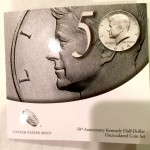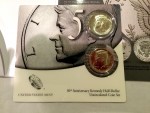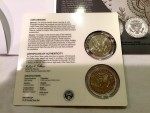Feb 2, 2015 | coins, legislative, policy, US Mint
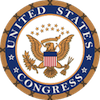 The 114th Congress was gaveled into session on January 5, 2015 with an air of optimism that both ends of Pennsylvania Avenue would be able to work together. Optimism can last as long as someone does not offend their opponent or there are significant lingering issues. Let the games begin.
The 114th Congress was gaveled into session on January 5, 2015 with an air of optimism that both ends of Pennsylvania Avenue would be able to work together. Optimism can last as long as someone does not offend their opponent or there are significant lingering issues. Let the games begin.
We open February with the New England Patriots winning the Super Bowl. Two weeks after the controversy over the deflation of the Patriots’ game balls, they came from behind and won the game on a last minute goal line interception. While many of the commercials were less than memorable, the game lived up to the super name. But for congress, it is only the first minutes of the game. With 23 months to go in the 114th Congress, the insanity is just beginning.
Here are the numismatic-related bills introduced in January:
S. 95: A bill to terminate the $1 presidential coin program
Sponsor: Sen. David Vitter (R-LA)
• Introduced in the Senate on January 7, 2015
• Referred to the Senate Homeland Security and Governmental Affairs Committee
Track this bill at https://www.govtrack.us/congress/bills/114/s95
H.R. 358: National Purple Heart Hall of Honor Commemorative Coin Act
Sponsor: Rep. Sean Maloney (D-NY)
• To require the Secretary of the Treasury to mint coins in commemoration of the National Purple Heart Hall of Honor.
• Proceeds paid to National Purple Heart Hall of Honor, Inc.
• Introduced in the House of Representatives on January 14, 2015
• Referred to the House Financial Services Committee
Track this bill at https://www.govtrack.us/congress/bills/114/hr358
H.R. 516: Cents and Sensibility Act
Sponsor: Rep. Steve Stivers (R-OH)
• To amend title 31, United States Code, to save the American taxpayers money by immediately altering the metallic composition of the one-cent, five-cent, dime, and quarter dollar coins
• Introduced in the House of Representatives on January 22, 2015
• Referred to the House Financial Services Committee
Track this bill at https://www.govtrack.us/congress/bills/114/hr516
In the days to come I will have a commentary on these bills. All three have flaws that congress keeps ignoring and it is time to take action to let them know how they can get things very wrong even on something as simple as coins. Stay tuned!
Jan 9, 2015 | news, US Mint
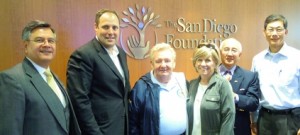
Rhett Jeppson (second from the left) will be joining the U.S. Mint as Principal Deputy Director
In making the announcement, Rios thanked Peterson for his service as Deputy Director. She noted that Peterson will continue to be a part of the team moving forward through the many important issues and initiatives the Mint will tackle this year.
Dick Peterson, the current Deputy Director, will return to the position of Deputy Director for Manufacturing and Quality, the job he was in prior to becoming Deputy Director.
Jeppson and Peterson are members of the Senior Executive Service (SES), the program that helps the U.S. government maintain a vibrant executive management system. As part of the SES program, government executives must take a new management position every three years. This way they maintain strong management skills and managers do not become entrenched and complacent in their jobs. Although SES guidelines encourage members to change agencies or major departments within the agencies, SES members can elect to stay in the same job with permission from the appointed executive who supervises their work.
Since the U.S. Mint does not have an appointed Director, Jeppson will be responsible for the day-to-day operation of the bureau—essentially, the U.S. Mint’s chief operating officer. Treasurer Rios remains the government equivalent of the Chief Executive Officer.
The U.S. Mint has not had a director since Edmund Moy resigned in January 2011. Given the current political climate, it is unlikely that the president will nominate a new director or, if he tries to nominate another candidate, the senate would confirm his nomination.
Dec 30, 2014 | coins, commemorative, commentary, legislative, policy, US Mint
And now, the end is near
And so I face the final curtain.
My friend, I’ll say it clear
I’ll state my case, of which I’m certain. . .
 As we wind down the end of a very interesting 2014, we also come to the end of the 113th Congress. This congress has been as inactive as any. Sure, there was a lot of press with faces from both sides spewing scary rhetoric about topics these people seem to know little about, but even when it comes to coining money, they have done less than any congress in recent memory.
As we wind down the end of a very interesting 2014, we also come to the end of the 113th Congress. This congress has been as inactive as any. Sure, there was a lot of press with faces from both sides spewing scary rhetoric about topics these people seem to know little about, but even when it comes to coining money, they have done less than any congress in recent memory.
Other than the passing the budget bill nicknamed “CRomnibus,” the 113th Congress passed only three bills that made it to the President’s desk. President Obama signed all three bills.
Bills Signed Into Law
- Public Law 113-10 (formerly H.R. 1071: To specify the size of the precious-metal blanks that will be used in the production of the National Baseball Hall of Fame commemorative coins. This was a technical change in the law that changed how the size of the planchet was determined that were not able to be considered when the law was introduced. This bill was signed into law by the President on May 17, 2013.
- Public Law 113-212 formerly H.R. 2366): The World War I American Veterans Centennial Commemorative Coin Act requires the Secretary of the Treasury to mint coins in commemoration of the centennial of World War I. In 2018, the U.S. Mint will strike not more than 350,000 silver dollar coins “emblematic of the centennial of America’s involvement in World War I.” The $10 per coin surcharge will be paid to the U.S. Foundation for the Commemoration of the World Wars to assist the World War I Centennial Commission in commemorating the centenary of World War I. This bill was signed into law by the President on December 16, 2014.
- Public Law 113-288 (formerly H.R. 2754: the Collectible Coin Protection Act. As I previously explained, this law enhances the Hobby Protection Act by allowing law enforcement and other legal actions against distributors and handlers of counterfeit coins and grading service holders. President Obama signed this bill into law on December 19, 2014.
Bills Passed by the House of Representatives
The following bill was passed by the House of Representatives but died in committee in the Senate.
- H.R. 2866: Boys Town Centennial Commemorative Coin Act
Bills Introduced in the House of Representatives
These are the bills that were introduced in the House of Representatives but died in the various committees. While it may not be apparent from the titles, all of these bills have some impact on the coinage that would be produced by the U.S. Mint:
- H.R. 77: Free Competition in Currency Act of 2013
- H.R. 220: Stop the Coin Act
- H.R. 627: National Park Service 100th Anniversary Commemorative Coin Act
- H.R. 1218: Commemorative Coins Reform Act of 2013
- H.R. 1653: Pro Football Hall of Fame Commemorative Coin Act
- H.R. 1719: Cents and Sensibility Act
- H.R. 1905: Mother’s Day Centennial Commemorative Coin Act
- H.R. 2366: World War I American Veterans Centennial Commemorative Coin Act
- H.R. 2633: Thirteenth Amendment Commemorative Coin Act
- H.R. 2760: Panama Canal and Pan-Pacific Exhibition Centennial Celebration Act
- H.R. 2932: United States Coast Guard Commemorative Coin Act
- H.R. 3146: Savings, Accountability, Value, and Efficiency (SAVE) II Act
- H.R. 3305: Currency Optimization, Innovation, and National Savings Act
- H.R. 3680: Breast Cancer Awareness Commemorative Coin Act
- H.R. 3729: Korean Immigration Commemorative Coin Act
Bills Introduced in the Senate
Coinage bills are considered revenue bills because they earn the federal government money and are used to raise funds that are paid by the government to public and private organizations. Even though the United States Constitution requires revenue bills to begin in the House of Representatives, it is not beneath the Senate to introduce their own legislation. Sometimes, senators introduce concurrent bills—bills that are similar to the one introduced in the House as a mechanism to get one of them passed. These are the bills that were introduced in the Senate that died in committee:
- S. 94: To terminate the $1 presidential coin program
- S.203: Pro Football Hall of Fame Commemorative Coin Act
- S. 768: Sound Money Promotion Act
- S. 1011: Boys Town Centennial Commemorative Coin Act
- S. 1105: Currency Optimization, Innovation, and National Savings Act
- S. 1158: National Park Service 100th Anniversary Commemorative Coin Act
- S. 1842: Pro Football Hall of Fame Commemorative Coin Act
- S. 2303: United States Coast Guard Commemorative Coin Act
- S. 2310: Mother’s Day Commemorative Coin Act
With that, we close the books on the 113th Congress.
Dec 24, 2014 | coins, gold, halves, silver, US Mint
Arriving in time to celebrate Festivus was my order from the U.S. Mint. The sense of timing was interesting since December 23rd was also the seventh day of Chanukah and the last of the eight candles would be lit that night and the day before Christmas Eve. Call it a celebration in a box!
In this order were my 50th Anniversary Kennedy Half-Dollar products. I first opened the 50th Anniversary Kennedy 2014 Half-Dollar Uncirculated Coin Set. Shrink wrapped, the set that sold for $9.95 was in a nice folder with a card containing two uncirculated coins in capsules embedded in the card. The half-dollars, one from Philadelphia and the other from Denver, are well struck and if I were to have them graded would probably be assigned a high grade.
Some people may balk at spending $5.00 for a half-dollar, but the presentation makes it a nice collectible even for the budget conscious.
Next was the 50th Anniversary Kennedy 2014 Half-Dollar Silver Coin Collection. The set contains four 90-percent silver half-dollars struck in four different finishes: reverse proof, proof, enhanced uncirculated, and uncirculated. This boxed set contains a presentation folder, Certificate of Authenticity from the U.S. Mint, and a booklet documenting how the Kennedy half-dollar came into being following the President’s assassination.
There is a somewhat cheesiness quality about the presentation. First, the outer cardboard sleeve that surrounds the box has a design that is repeated on the box top. The same design is on the outer flap of the folder itself. Esthetically, this type of design is visually fatiguing by the time you are to the point of opening the folder. In the past, the U.S. Mint used their logo or a heraldic eagle. It broke up the visual monotony created by using the same imprint on three different surfaces.
Another problem with the product design is that the encapsulated coins are embedded into a holder that is only one sided. In order to see the reverse of the coins they have to be removed from what holds them into the folder. Unfortunately, the fitting is so tight that it I started to pull apart the part of the folder that attaches the capsules to the folder. Eventually, I used a letter opener to gently pry the capsules out of their slots so that I could see the reverses.
-
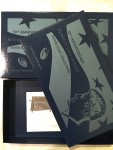
-
Packaging of the 50th Anniversary Kennedy Half-Dollar Silver Set
-
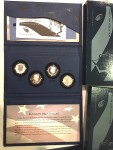
-
The folder with all four coins in the 50th Anniversary Kennedy Half-Dollar Silver Set
-
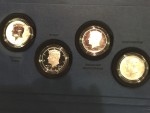
-
A close-up of the silver half-dollars in the 50th Anniversary Kennedy Half-Dollar Silver Set
It was worth the trouble removing the capsules from their holders. All the coins were beautifully struck and looked great including the reverse proof struck in West Point. I love the look of the reverse proof coin. Aside from having Kennedy really standing out on the obverse, there is something regal looking about the heraldic eagle on the reverse.
At first glance there almost appears to be no difference between the proof coin, struck in Philadelphia, and the enhanced uncirculated coin struck in San Francisco. After placing the coins side-by-side it was evident that he proof coin was struck differently than the enhanced uncirculated coin. Proof coins are usually struck with more force and more than once. Looking at both coins together before using a loupe shows that the relief for the proof half-dollar was higher. You can really see the difference by looking at Kennedy’s hair which showed more definition in the proof coin.
Where the enhanced uncirculated coin has an impact is on the reverse. Whereas the elements on a proof coin are frosted the laser process used on the enhanced uncirculated coins allows the U.S. Mint to create the frosting effect on some of the elements. For the reverse of the enhanced uncirculated half-dollar, the U.S. Mint selectively frosted elements of the heraldic eagle giving a “pop” that would not be possible using any other method. By frosting some of the higher relief areas, especially around the eagle’s shield, it provides a visual cue of more depth which makes for a nice refresh of a 50 year-old design.
-
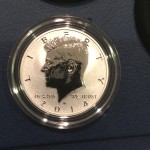
-
The obverse of the 2014-W reverse proof in the 50th Anniversary Kennedy Half-Dollar Silver Set
-
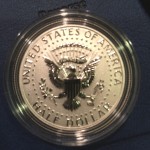
-
The reverse of the 2014-W reverse proof in the 50th Anniversary Kennedy Half-Dollar Silver Set
-
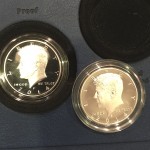
-
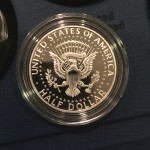
-
The reverse of the 2014-S enhance uncirculated Kennedy silver Half-Dollar
As I write this, the London Fix price of gold is $1,170 per troy ounce. If the PM Fix of gold stays below $1,200, the price of the 50th Anniversary Kennedy 2014 Half-Dollar Gold Proof Coin will drop to $1,165, down from its current $1,202 and will be $75 less than its first issued price of $1,240. Although it is not a good idea to try to time the market, I wonder if all those dealers who caused problems during the coin’s initial release are worried about their profit margins now that the price of gold is going down!
Dec 11, 2014 | BEP, legislative, news, US Mint
In a normal world, the United States congress will pass twelve different budget bills by August or September in time for the beginning of the federal government’s fiscal year, which begins on October 1. Anyone who has followed congress over the last 20-or-more years knows that the world they live in is not normal. Rather than pass real budget bills, congress has learned the irresponsible habit of voting on continuing resolutions and omnibus funding bills.
A continuing resolution (CR) is a bill that says to take the previously passed budget and extend it to a specific date. CRs can either continue the spending or make certain adjustments, such as reducing spending by a percentage. Omnibus, from the Latin “for everything,” are bills that are loaded with every bit of budget information in one very long bill.
Within the Omnibus budget bill are provisions to provide funding for the government’s money manufacturing operations. But this is different type of bill. It is an omnibus spending bill that covers most of the government through the end of this fiscal year (September) and a CR for the Department of Homeland Security so that the new congress can fight with the president over other policy matters. Reporters have been calling this a CRomnibus bill—which should never be confused with a cronut which is a very sweet treat! According to NBC News:
And the Washington word of the week is: “Cromnibus.” It’s the love child of a “continuing resolution” (CR) and “ omnibus” spending bill, two inside-the-Beltway terms for measures Congress has approved to keep the government funded.
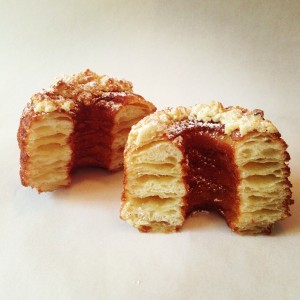
TASTY!
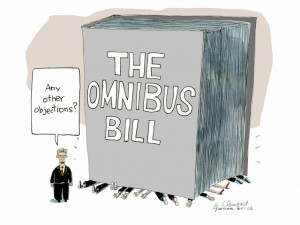
Not so tasty!
For the U.S. Mint, the bill recognizes that their funding is provided by its seigniorage that is deposited in the United States Mint Public Enterprise Fund (31 U.S.C § 5136) and does not receive appropriations from the general Treasury. Congress can limit the amount that the U.S. Mint can spend from the Public Enterprise Fund. In the Omnibus Budget Bill waiting for congress to vote on, the U.S. Mint is limited to spending $20 million.
In the grand scheme of the U.S. federal government, $20 million is not a lot of money. However, it may be more than enough for the U.S. Mint to operate. According most fiscal year 2013 (FY13) annual report from the U.S. Mint, the latest report available when this is written, the U.S. Mint spent $11.89 million for FY13 and $12.03 million in FY12. If the cost cutting measures implemented by Deputy Director Richard Peterson this past year further reduces costs, the $20 million could be twice as much as the U.S. Mint needs to operate.
Appropriation for the Bureau of Engraving and Printing has a few different provisions. Although it does recognize that the BEP has what the bill calls an “industrial fund,” (31 U.S. Code § 5142), the bill does not place many limits on what the BEP can use. The bill says that the BEP cannot use the monies to redesign the $1 Federal Reserve Note making it the second oldest design used on U.S. money.
For double-extra brownie points, what is the oldest design used on U.S. money?
The other limit is that the BEP can use only up to $5,000 for “official reception and representation expenses.” Essentially, the BEP can only spend up to $5,000 for conferences and conference attendance. Does this mean that the BEP will not be at shows like the World’s Fair of Money because it would cost more than the $5,000 to bring their exhibit to Rosemont, Illinois next August? If the BEP does not attend the World’s Fair of Money or other shows, tell your representatives in congress that their short-sightedness is hurting the hobby!
Finally, the bill says that the money appropriated “may be used to consolidate any or all functions of the Bureau of Engraving and Printing and the United States Mint without the explicit approval of the House Committee on Financial Services; the Senate Committee on Banking, Housing, and Urban Affairs; and the Committees on Appropriations of the House of Representatives and the Senate.” In other words, if someone figures out that the BEP and U.S. Mint can become more efficient and further save money by combining certain functions they have to go to congress and ask for permission.
I wonder what congress would say if the BEP and U.S. Mint were to propose to consolidate their online and brick-and-mortar retail operations? Instead of two different operations, how much could be saved if these bureaus under the Department of the Treasury would have one fulfillment contractor or a combined storefront in their current locations?
Of course this is contingent on congress passing this budget. As I write this, the government is a few hours away from running out of money with no signs of being able to pass this bill. However, if the government shuts down the U.S. Mint and BEP will continue operating since they are self-funded organizations.
UPDATE: (12/12/14 00:45) The CRomnibus bill passed the House about 10:00 PM on Thursday but still needs to be passed by the Senate before it can be signed by the President into law. The House passed a stop-gap bill to give the Senate until this weekend to pass the CRomnibus bill. Crisis averted, but the money manufacturing process continues.
Image of the Cronut courtesy of
Dominique Ansel Bakery, where it was invented.
Cartoon about the Omnibus bill is actually Canadian by Gary Clement and appeared in the
National Post. Who cares if it’s Canadian. It’s fitting!
Dec 10, 2014 | bullion, coins, Eagles, halves, silver, US Mint
A couple of quick news items that came out of the U.S. Mint on Tuesday.
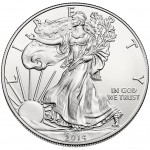 The U.S. Mint reported that as of December 8, 2014, they had sold a record 42,864,000 one troy ounce American Silver Eagle Bullion coins for all of 2014. This beats the previous record of 42,675,000 coins sold in 2013. Sales of the 2014 bullion coins to authorized dealers will end during the week of December 15.
The U.S. Mint reported that as of December 8, 2014, they had sold a record 42,864,000 one troy ounce American Silver Eagle Bullion coins for all of 2014. This beats the previous record of 42,675,000 coins sold in 2013. Sales of the 2014 bullion coins to authorized dealers will end during the week of December 15.
Taking a sample of five different bullion dealers, the average price is around $20 for one American Silver Eagle Bullion coin. If each coin is worth about $20 each, that means the U.S. Mint sold $857.28 million in silver bullion for 2014. Remember, this is for the bullion coin. This does not count the collectible versions such as the proof or the West Point struck uncirculated coin.
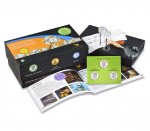 The other announcement was that the U.S. Mint will sell a new product, Coin Discovery Set — An Introduction to Coin Collecting. The set costing $24.95 will include three 2014 Kennedy Half-Dollars in three different finishes—proof, uncirculated and circulating. It will also include two coin tubes for quarters, a magnifying glass, cotton gloves, and a booklet that explains the coin production process. The box will the the size to store U.S. Mint proof sets.
The other announcement was that the U.S. Mint will sell a new product, Coin Discovery Set — An Introduction to Coin Collecting. The set costing $24.95 will include three 2014 Kennedy Half-Dollars in three different finishes—proof, uncirculated and circulating. It will also include two coin tubes for quarters, a magnifying glass, cotton gloves, and a booklet that explains the coin production process. The box will the the size to store U.S. Mint proof sets.
Sales will open at noon Eastern Standard Time (1600 UTC) on Tuesday December 16, 2014. While there will be no household ordering limit, the U.S. Mint has set a product limit to 45,000 sets.
Images courtesy of the U.S. Mint.
Nov 6, 2014 | bullion, coins, commentary, gold, US Mint
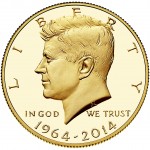 Every Thursday morning, the U.S. Mint looks at the afternoon London Fix price of gold and adjust their bullion-related coins based on their published tables. This morning, the U.S. Mint adjusted prices after noting that the afternoon London Fix priced gold at $1,145.00 per troy ounce. Based on the table published in the Federal Register, the price of the 50th Anniversary Kennedy 2014 Half-Dollar Gold Proof Coin was reduced to $1,165.00!
Every Thursday morning, the U.S. Mint looks at the afternoon London Fix price of gold and adjust their bullion-related coins based on their published tables. This morning, the U.S. Mint adjusted prices after noting that the afternoon London Fix priced gold at $1,145.00 per troy ounce. Based on the table published in the Federal Register, the price of the 50th Anniversary Kennedy 2014 Half-Dollar Gold Proof Coin was reduced to $1,165.00!
Please pardon me as I laugh at all of those dealers whose questionable ethics caused despicable scenes in Philadelphia, Washington, Denver, and Rosemont at the ANA World’s Fair of Money when the introduction price was $1,240. Those who have waited to order the coin directly from the U.S. Mint for a coin that does not have a mintage limit will have saved $75 from the issue price. And by buying from the U.S. Mint, you do not have to pay the alleged “numismatic premium” dealers will apply for the special label encased on the plastic they paid to have the coin entombed in.
Regardless of what the politicians say, some business pundits recognize that the economy is moving forward and the stronger dollar will continue to push prices lower.
If the price of gold drops below $1,100 by next Wednesday afternoon’s London Gold Fix, the price of the Kennedy gold halves will drop to $1,127.50. If that happens, I will be back to laugh even more!
Oct 31, 2014 | ANA, CCAC, coin design, coins, commemorative, commentary, gold, halves, medals, policy, silver, US Mint
 It has been a few years since I did an All-Hallows-Eve numismatic trick-or-treat that it seems like a good time to do add one. Here are my numismatic tricks and treats for this past year.
It has been a few years since I did an All-Hallows-Eve numismatic trick-or-treat that it seems like a good time to do add one. Here are my numismatic tricks and treats for this past year.
Girl Scouts need a values adustment
TRICK: It was announced in January that the 2013 Girl Scouts commemorative coin did not generate enough sales for the U.S. Mint to provide a payout of seignorage. This is the first time this has happened. Part of the problem was that the Girl Scouts are stuck in the 1950s mindset that does not see collecting coins as a girl’s hobby. Although values are important, this shows that he Girl Scouts’ values are behind the times and will not be the catalyst behind helping expand the hobby. They should be ashamed for contributing to this failure.
ANA Willfully Gives up its Premier Status
TRICK:The Professional Numismatists Guild and the American Numismatic Association announced in January that “the first” PNG-ANA Numismatic Trade Show the weekend prior to the 2014 World’s Fair of Money in Rosemont that it will be open to the public. While making it sound exciting it made the entire show 8-days long. This was a bad move because of the length and because it makes the ANA play second to PNG. If the ANA wants to be the premier numismatic organization, the one that anyone wanting to learn about and be about numismatics, The ANA should not play second fiddle to any other organization.
There are coin treats!
TREAT:In creating a tribute to the 50th anniversary of the Kenney half-dollar, the U.S. Mint has made a coin that is not really circulated into something interesting for the collector. The dual-dated gold coin became an instant hit before the price of gold dropped and the silver sets are reportedly selling well. This was a good move by the U.S. Mint.
TREAT:For the most part, commemorative coins are sales do not meet expectation. While there are a few exceptions like 2005 Marine Corps 230th Anniversary silver dollar, most commemoratives do not come close to their maximum mintage. But the 2014 National Baseball Hall of Fame commemoratives appear to have hit a home run. The combination of the subject and the curve of the coin may be a significant factor in the coin’s success. The $5 gold and silver dollar coins are both sold out. There are some of the clad half-dollars available.
TREAT:Speaking of cool stories, what about the Saddle Ridge Hoard? After a couple found the hoard of gold coins while walking their dog, it spawned an interest in metal detectors and searching for buried treasure. It was such an amazing story that it even found its way into the national news cycle. But like everything else, another shiny story diverted the media’s attention and the coins went on sale to the general public on Amazon.com.
Not all coins are treats
TRICK: Colored and coins with gimmicks are proliferating in the market. So far, the U.S. Mint and the Royal Mint are resisting colored and other gimmicks while the Royal Candian Mint and New Zealand Mint are at a race to the bottom for gimmick coins.
Numsimatics and technology
TREAT: The ANA launched its new website with new technology ready for growth on time and under budget. This is the website that ANA Governor Laura Sperber said, “I can’t wait to see what a disaster the ANA new web site will be.” So far, there has not been a follow up from Sperber while the new site has been a success.
TREAT: More recently, the U.S. Mint had a great launch to their new website. After years of frustration with the online ordering of what would be popular items, the new site handled the launch of the 50th Anniversary Kennedy 2014 Half-Dollar Silver Coin Collection with no issues.
Failure to launch
TRICK: The U.S. Mint launched the Baseball Hall of Fame commemorative coin at the Whitman Show in March not anticipating its popularity with fewer coins that there was a demand. It was as if the U.S. Mint had a blind spot with how popular this coin would be.
TRICK: The dealers who paid less than desireable people uninterested in anything other than a quick buck to mob the lines at the Denver Mint and the World’s Fair of Money. I continue to belive that their ethics must be questioned and appropriate actions taken by the ANA even though I do not think that will happen.
TREAT: With the drop in the price of gold, the current price of the gold Kennedy half-dollar tribute is less than what is was at launch. Teach these greedy dealers a lesson and buy the coins for less directly from the U.S. Mint!
U.S. Government hands out coal
TRICK: Because the U.S. Mint can only do what the laws that congress pass tells them they can do and congress is so dysfunctional they cannot even pass laws for issues they agree on, the United States was the only country involved with the Allies on D-Day NOT to issued a commemorative to honor the 70th anniversary of D-Day.
TRICK: In the name of political correctness, the State Department’s Cultural Property Advisory Committee (CPAC) continues to make it difficult for ancient coin collectors to participate in its hobby by allowing countries to ask the State Department to overreach on the enforcement on the Cultural Property Implementation Act. It is turning ancient coin collectors into criminals even for collecting common coins. Their actions are rediculous.
CCAC is the CCAC
TREAT: The Citizens Coinage Advisory Committee suggested creating American Arts medals that will feature the artistic ability of the U.S. Mint’s artist.
TRICK: The arts medals are medals, not coins. Even with the beauty of medals like the 9/11 silver medal, it did not sell like coins would. In fact, it grossly under performed without raising significant sums for the 9/11 Memorial at the site of the Twin Towers in New York. But this is what the CCAC is face with because of congressional dysfunction (see above).
So goodbye everybody, and remember the terrible lesson you learned tonight. That grinning, glowing, globular invader of your living room is an inhabitant of the pumpkin patch, and if your doorbell rings and nobody’s there, that was no Martian… it’s Hallowe’en.
— Orson Welles, The War of the Worlds, CBS Radio, October 30, 1938

Hobo Ike and Jefferson courtesy of Darth Morgan posted at
Coin CommunityOct 29, 2014 | coins, halves, silver, US Mint
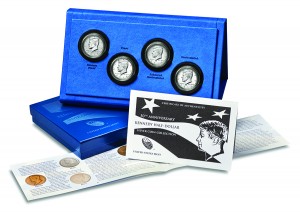
2014 Kennedy 50th Anniversary Silver Collection
Each of the four coins will have different finishes. There will be one reverse-proof coin from West Point, a proof coin from Philadelphia, and uncirculated coin from Denver, and an enhanced uncirculated coin from San Francisco. The enhanced uncirculated coin will be struck on dies that will use a laser frosting and special wire brush treatments to enhance the design. The wire brush treatment is something new to the U.S. Mint that has not been seen on any publicly released coins or medals.
What is even more impressive is that the new computer ordering system withstood the challenge of a new product offering. In years past, the computer ordering for popular U.S. Mint products had sent the computer system into fits while trying to keep up with the requests. By all accounts, the computer system not only processed every order in a timely manner, but the U.S. Mint reports that the site was working at a rate of 14 orders per second and that the average peaked at 24.9 orders per second.
Orders for the set began at noon and after a half hour, 36,000 units were sold translating into $3.6 million in sales. As of midnight, 12 hours after opening the sale, the U.S. Mint sold 85,670 sets. The U.S. Mint is reporting that by 8:30 PM, they shipped 14,000. They started with 180,000 sets in stock which means there is time to order yours and to have it processed quickly.
For those of us who suffered through the pain of ordering of products line the American Eagle 25th Anniversary Silver Coin Set, the performance of the new website is a welcome change.
While the new website looks good and sports more modern functionality, it seems to perform well and works more smoothly than the old site. Unfortunately, I am not sure that I like the way the site is organized. My primary complaint is that the site is designed as a shopping site that seems to have buried the information about the coin programs. There should be a better balance between their mission as the government’s manufacturer of coins and the sales of those coins.
After years of frustration with the U.S. Mint, it looks like they are really working to serve its clientele including the Federal Reserve, which it is required to produce coins for by law. Maybe it has served the country well by having a professional run the U.S. Mint rather than a politician.
Oct 16, 2014 | CCAC, coins, First Spouse, gold, news, US Mint
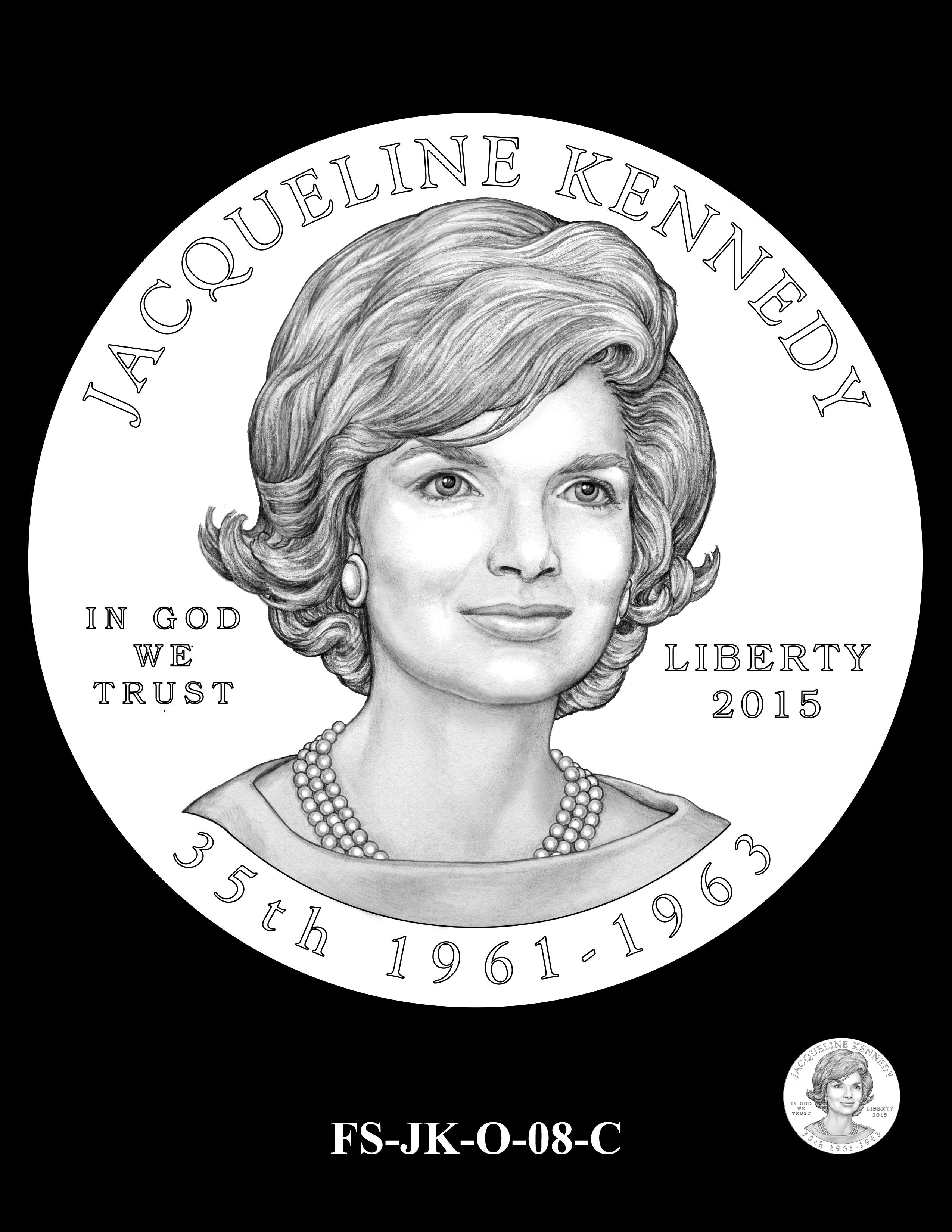
The obverse design selected by the CCAC for the Jacqueline Kennedy First Spouse Gold Coin
For Kennedy, in addition to being renown, the release of the 2014 50th Anniversary Kennedy Half-Dollar Gold Proof Coin may cause a sharp increase in demand from customers seeking to make special Kennedy gold sets using both the 2014 50th Anniversary Kennedy Half-Dollar Gold Proof Coin and the 2015 Jacqueline Kennedy First Spouse Gold Proof Coin. To account for this potential variable, we believe a maximum issuance of 30,000 coins would allow flexibility to increase production should customer demand exceed forecasted sales volumes for the other designs. These maximum mintage limits will be divided between coins with proof and uncirculated finishes based on consumer demand.
The Mint is not obligated to mint, and will not mint, to the maximum mintage limits unless it is supported by public demand. The production process and maximum mintages give us flexibility should there be a surge in demand over previous years.
 The 114th Congress was gaveled into session on January 5, 2015 with an air of optimism that both ends of Pennsylvania Avenue would be able to work together. Optimism can last as long as someone does not offend their opponent or there are significant lingering issues. Let the games begin.
The 114th Congress was gaveled into session on January 5, 2015 with an air of optimism that both ends of Pennsylvania Avenue would be able to work together. Optimism can last as long as someone does not offend their opponent or there are significant lingering issues. Let the games begin.
 As we wind down the end of a very interesting 2014, we also come to the end of the 113th Congress. This congress has been as inactive as any. Sure, there was a lot of press with faces from both sides spewing scary rhetoric about topics these people seem to know little about, but even when it comes to coining money, they have done less than any congress in recent memory.
As we wind down the end of a very interesting 2014, we also come to the end of the 113th Congress. This congress has been as inactive as any. Sure, there was a lot of press with faces from both sides spewing scary rhetoric about topics these people seem to know little about, but even when it comes to coining money, they have done less than any congress in recent memory.